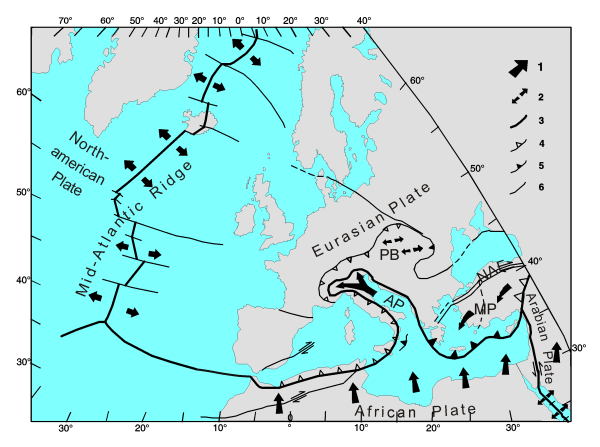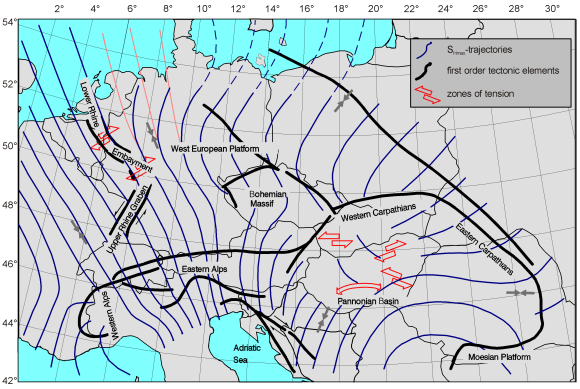The crustal stress field in Europe as source of earthquakes
The immediate trigger of an earthquake and the propagation of seismic wave energy is the sudden movement of tectonic blocks at geologic faults. Stresses in the brittle parts of the earth’s crust and mantle cause the tectonic forces which lead to large scale deformations. At the geologic faults, i.e. joints, adjustments of the stresses can take place as aseismic creep movement and/or earthquakes. A fault of first order marks the plate boundaries. Here a much larger part of the deformation energy is released than in the interior of the continents.
The western part of the Eurasian plate is pictured in Figure 1, where the plate boundaries are specially marked. The earthquake activity is concentrated to the boundaries. At the southern border of the Eurasian plate, Figure 1 shows the northerly bulge of the Apulian promontory (AP), which during its northerly movement has pushed up the Alps ahead of it. There is a considerable resistance to this northerly drift of Africa. The similar northerly oriented movement of the Arabian plate is exposed to much less resistance and is therefore faster than that for Africa. The two microplates (MP) in the Anatolia area which are schematically indicated are caused to drift westward by the Arabian plate, which, e.g. is manifested in significant movements accompanied by strong earthquakes at the North Anatolian Fault (NAF). In the Aegean Sea area and southeast of the Tyrrhenian Sea, oceanic African crust is submerging during the northerly oriented movement. The by far largest part of the European seismicity is concentrated to this plate boundary between Eurasia and Africa.

The forces counteracting the northerly movement of Africa originate at the Midatlantic Ridge, whereby flow processes in the mantle widen the ridge and floating magma intrudes, solidifies and leads to a broadening of the Atlantic Ocean. These processes are connected to strong seismic activity, which depicts the contours of the Midatlantic Ridge very clearly in epicentre maps.
Forces related to the global plate tectonics cause the stress field of central Europe in a wide sense. The lines represent trajectories of maximum horizontal compression in the crust. This image of the stress field is the result of numerous stress measurements and further stress observations as well as numerical modelling, with which the data can be surprisingly well reproduced. In the Pannonian Basin, additional extensive forces are acting, which produce the nearly radial stress structure around the basin.
The stress pattern can cause earthquake generating processes at faults which are arranged in special angles to the stress trajectories. The fault pattern combined with knowledge of the stress field is the key to the understanding of the spatial distribution of earthquakes, since not every fault, most frequently created in the geologic past, is predestinated to generate earthquakes in combination with the current crustal stress field.


